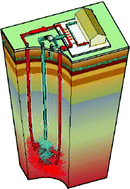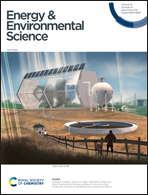The evolving role of geothermal energy for decarbonizing the United States†
Abstract
Geothermal energy is often referred to as a niche technology that is too localized, too small or too expensive to make much of a difference in how renewable energy will be supplied in a fully decarbonized future. As a result, geothermal energy has been undervalued in terms of what it could provide to complement, rather than compete with, electricity generation from wind, solar photovoltaic, concentrating solar power and other renewables. Geothermal energy systems are fully dispatchable and can provide baseload or load-following electric power or heat suitable for a wide range of applications including supplying district heating for communities and cities, and heating and cooling of individual buildings. The focus of our study is on the potential of utilizing geothermal energy for providing heat for buildings and industry at lower temperatures, a substitute for the combustion of fossil fuels. Because heating represents about 20% (20 EJ per year) of the annual primary energy consumption in the U.S.—with most of it coming from burning natural gas, oil and/or propane in furnaces—deploying geothermal heating on a national scale could have a significant impact on lowering carbon emissions. In heating-dominated states in the U.S. Northern Tier, heating often is among the largest contributors to the state's carbon footprint. This review begins with a discussion of the motivation and rationale behind considering geothermal as a key low-carbon heating option for the U.S. The study summarizes the U.S. geothermal resource and describes the applications and main engineering components of using geothermal energy for heating and cooling, electric power generation, and co-generation using district heating, geothermal heat pumps, and power conversion with steam flashing and organic Rankine plants. Environmental benefits and impacts are described. An extensive discussion of geologic and thermal-hydraulic aspects of the subsurface is included in the review because of their critical role in determining reservoir designs at specific sites to ensure sufficient productivity that is both safe and economically viable. Models for estimating levelized costs of district heating are used to show how costs are affected by reservoir performance, infrastructure capital costs, and financial parameters. The review concludes with an assessment of technical subsurface issues associated with reservoir performance and the economic requirements for providing geothermal heating in district heating systems at a sufficient scale to have an impact on decarbonizing the U.S.



 Please wait while we load your content...
Please wait while we load your content...